|
|
|||
|
All text & photos © Hilton Pond Center Since mid-October 2003, a seemingly small hummingbird had been coming to a feeder in Weddington NC (Union County), but it wasn't until seeing a note in The Charlotte Observer that David & Sherry Suich realized just how unusual it was to host this out-of-season visitor. After reading Nancy Brachey's column on 21 February, they contacted us via E-mail at Hilton Pond Center. At the time we were on a field trip to Costa Rica, and it was only when we returned from a follow-up trip to Iowa that we were able to attend to the business of visiting the Suichs to see about banding their winter hummer.
We finally arranged a trip to Weddington on 3 February 2004, arriving at 6:30 a.m. in time to place the Suichs' feeder in our portable hummingbird trap and hang the apparatus above their back deck. When David asked how long it would take to catch the bird, we responded that it could be three minutes--or three hours. This turned out to be a grossly pessimistic estimate.
As we walked into the Suich living room and asked David to flip wall switches so we wouldn't be backlit by overhead lights, the hummingbird sped into view and entered the trap. We quickly hit the button on our remote transmitter and watched as the trapdoor slid shut behind the Suichs' hummingbird. Total time from trap set to capture: less than 45 seconds.
Although Sherry Suich had been calling this winter bird a "she," we mentioned that young male hummingbirds often resemble females of their species. In fact, once we had her bird in hand, we still thought this bird was rather small--typical of many kinds of male hummers--and when we measured the bird, it did fall within the range of a male Rufous Hummingbird, Selasphorus rufus. These measurements were misleading, however, because the longest wing feather--i.e., the tenth (outermost) primary--was in quill, and the longest tail feather (rectrix #1) was also only partially grown (see two photos below). Thus, the measurements were invalid for sexing the bird and we had to rely instead on plumage characteristics.
This bird--which hatched sometime in or before 2003 on the species' breeding grounds in southern Alaska, western Canada, or the northwestern U.S.--had iridescent color on its throat. In many gorgetted hummer species--our summer Ruby-throat Hummingbirds are one of the exceptions--females have several metallic feathers on their throats, as do young males. (Adult males in these species have full metallic gorgets--hence the name "Ruby-throated Hummingbird.") The Weddington bird, however, was devoid of rusty head or back feathers that would be expected on a male Rufous in March of its second year. In addition, the cheek and throat were lacking color and dark streaking of a second year male that might not yet have developed a rusty back and crown. Thus, after some head scratching and eventual consultation with Nancy Newfield--the true queen of winter hummingbird banders--we decided it was prudent to conclude the Weddington bird was an after hatch year female.
Vital Statistics for
All text & photos © Hilton Pond Center
If you're interested in sharing your hummingbird observations and learning from other enthusiasts, you may wish to subscribe to Hummingbird Hobnob, our Yahoo!-based discussion group. Also be sure to visit our award-winning Web site for Operation RubyThroat: The Hummingbird Project; on it you'll find almost anything you want to know about hummingbirds, including more information about Hummingbird Banding.
For much more information about hummingbirds, visit: |
|
Make direct donations on-line through
Network for Good: |
|
|
LIKE TO SHOP ON-LINE?
Donate a portion of your purchase price from 500+ top on-line stores via iGive: |
|
|
Use your PayPal account
to make direct donations: |
|
|
Back to Vagrant & Winter Hummingbird Banding Back to This Week at Hilton Pond Back to What's New? Current Weather Conditions at Hilton Pond Center |
|
Join the |
|
post questions for The Piedmont Naturalist |
Join the |
Search Engine for |
|
|

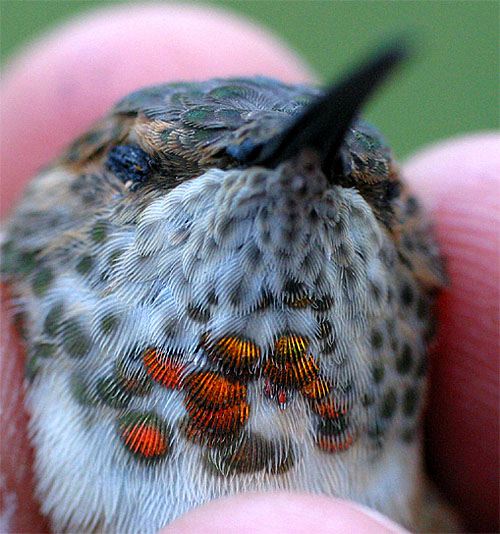
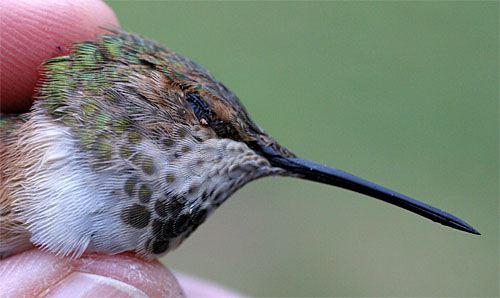


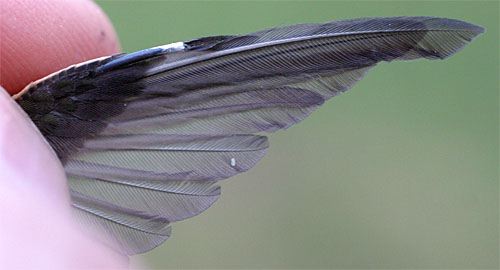
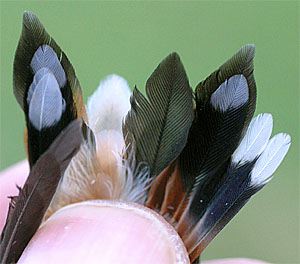 The whole time we were measuring, banding, ageing, and sexing the Suichs' hummingbird, David kept his camcorder rolling. We're sure he'll share the tape many times with friends and family who weren't lucky enough to have such an unusual winter visitor--one that undoubtedly would be departing sometime soon to return to its breeding grounds in western North America. After photographing the bird that had spent the winter with Sherry & David Suich, we gently inserted its bill in a feeder port and watched while it lapped up sugar water. Then we released the hummer, packed up our trap and banding gear, and aimed our travelin' van across the border toward
The whole time we were measuring, banding, ageing, and sexing the Suichs' hummingbird, David kept his camcorder rolling. We're sure he'll share the tape many times with friends and family who weren't lucky enough to have such an unusual winter visitor--one that undoubtedly would be departing sometime soon to return to its breeding grounds in western North America. After photographing the bird that had spent the winter with Sherry & David Suich, we gently inserted its bill in a feeder port and watched while it lapped up sugar water. Then we released the hummer, packed up our trap and banding gear, and aimed our travelin' van across the border toward 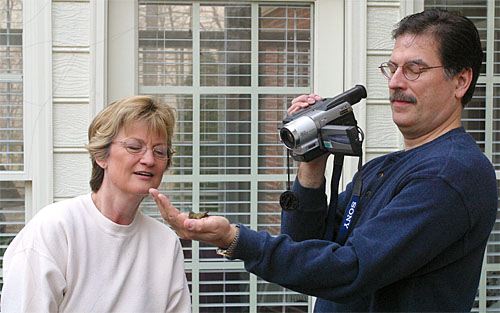

 Students at GLOBE-certified schools may submit winter hummingbird observations as part of Operation RubyThroat and GLOBE. Students can also correlate hummingbird observations with data on abiotic factors, including atmosphere, climate, hydrology, soils, land cover, and phenology. See the
Students at GLOBE-certified schools may submit winter hummingbird observations as part of Operation RubyThroat and GLOBE. Students can also correlate hummingbird observations with data on abiotic factors, including atmosphere, climate, hydrology, soils, land cover, and phenology. See the 



